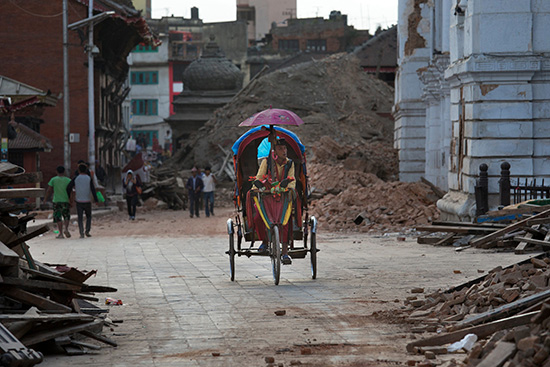
Puffs, then billows, of dust rose from various parts of the city, within minutes shrouding the whole valley in a brown blanket. Kathmandu disappeared, writes Nepali Times editor Kunda Dixit.
KATHMANDU, Nepal: It had been an unseasonably cold and rainy Saturday morning. Twelve of us from the staff of The Nepali Times were on a hiking retreat on a hill overlooking the city. The sky was overcast, and we were disappointed not to have a view of the Himalayas to the north. Some of us looked down at the capital spreading out in the bowl-shaped valley below and talked about its rapid, haphazard growth.
As we were descending along the ridge, about a two hours’ walk away, suddenly there was a big jolt. The whole mountain started bobbing, as if set on the ocean. We could barely stay standing.
“This is the Big One,” I thought.
Kathmandu is first on the list of cities deemed most vulnerable to seismic risk in the world. Every year in mid-January, Nepal marks National Earthquake Safety Day to commemorate the massive earthquake that flattened Kathmandu in 1934.
Our newspaper’s coverage of that occasion this year had highlighted the need for Nepal to better prepare for a disaster; it was only a matter of time before the next one hit.
Puffs, then billows, of dust rose from various parts of the city, within minutes shrouding the whole valley in a brown blanket. The historic town of Bhaktapur, at the eastern edge, looked like it was being swallowed by a sand storm. Kathmandu disappeared.
Shock turned to fear
Our sense of shock turned to fear as we thought of our families down below. Worst-case predictions had forecast that an 8-magnitude quake in Kathmandu could kill 100,000 people, injure 300,000 and level the city. We hugged each other, some of us crying. We reached for our phones. The lines were down.
An hour later, as we were still walking downhill, there was another tremor. I felt like I was being yanked forward a couple of metres. The whole mountain seemed to lurch. There were more dust clouds. After those cleared, we noticed through our binoculars that most of the residential areas of the city seemed intact. That brought us some measure of relief.
A few members of our group had managed to contact their relatives. But four of us had not, and we hurried back. We retrieved my car parked at the foot of the hill, and headed into town. On the road we had to skirt fallen masonry and tilted buildings.
People were sitting clustered in open spaces or in the middle of the streets, as far as possible from anything that might collapse. In front of a hospital, we saw patients lying on mattresses set out on the sidewalk.
By late Saturday afternoon, it started becoming clear that though in Kathmandu the casualties were high and the damage was serious, notably at various World Heritage sites, the quake’s effects might not be quite as devastating as feared.
My own family was safe, though my bed-ridden mother had to be carried out into the garden; we live in the residential part of Patan, where buildings are sturdier.
But the devastation was expected to be far more severe in the mountains near the epicenter, about 80km northwest of the capital, and in the surrounding districts.
Reports — including from one resident of Barpak village, to the north, who had walked eight hours to get a phone signal — were just trickling in that entire villages have been wiped out. Landslides were blocking rivers. The highways were unusable.
Any government in the world would have been overwhelmed by the scale of this disaster, but the logistical difficulties in Nepal, a poor, near-roadless, mountainous land, are extraordinary.
The country’s only international airport is still operational, and China and India quickly started flying in relief help. But the Nepali Army itself has only one big helicopter.
Nepal’s unstable political scene is another major obstacle. After a decade of conflict between the government and Maoist insurgents, Nepal’s politicians have been too busy battling one another, most recently over constitutional reform, to treat disaster preparedness as a priority.
There have been no elections at the district, village or municipal level for almost two decades, and the committees that run local councils aren’t organised to coordinate emergency assistance.
Community groups
And so much of the relief work has fallen on community groups; some, like the one headed by Gopal Awale in Patan, had devised some basic emergency plans in case of a disaster.
On Saturday, such groups were helping take people away from the old buildings of Kathmandu’s inner city, which were hit especially hard, and putting them up in tents in schools, parks and other designated safe areas.
Hundreds of thousands of people in Kathmandu and surrounding areas spent Saturday night on the streets. My family and I slept in a tent in our backyard.
It has now been more than 24 hours since the first quake, and by my count we have since been rocked by more than 50 tremors, some major. Yet there is no sign of overt panic. On Sunday, people in my neighborhood were gathering water bottles and sleeping bags, calmly hunkering down for another night out in the open.
Nepali Times editor Kunda Dixit wrote this commentary for The New York Times. He gave permission for it to be republished by the Pacific Media Centre.
Baby pulled from earthquake rubble after 22 hours
EYEWITNESS OPINION
The Nepali Times editor Kunda Dixit, keynote speaker at an investigative journalism conference at AUT in 2010, reports for The New York Times.
Another good news story from this week's earthquake disaster was the discovery of missing baby #sonies after 22 hours.




